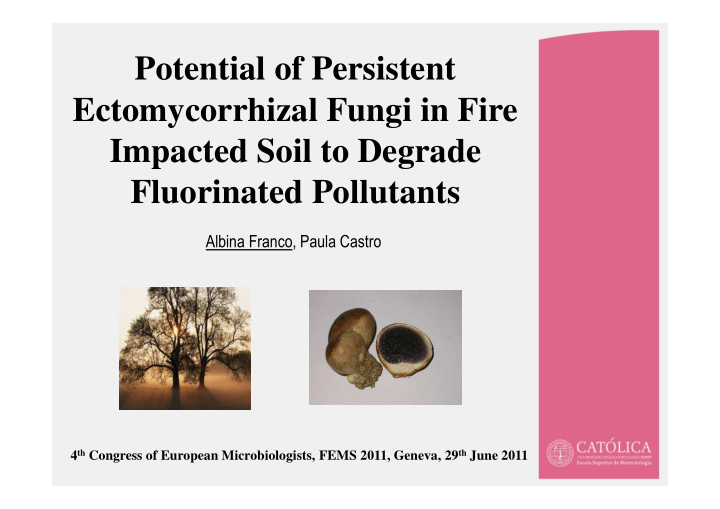



Potential of Persistent Ectomycorrhizal Fungi in Fire Impacted Soil to Degrade Fluorinated Pollutants ���������������������������� 4 th Congress of European Microbiologists, FEMS 2011, Geneva, 29 th June 2011
Over the last decades, the widespread use of halogenated chemicals , e.g., agriculture, pharmaceuticals, fire retardants, has increased Most of these compounds accumulate in soils , sediments and water resources However, their effect and fate in natural environments is still unclear
Most studies have been focused on bacteria capacity to degrade fluorinated compounds Fungi, such as Ectomycorrhizal fungi – ECM, are often neglected as important players in remediation processes Assessment of the potential contribution of ECM fungi as a rhizosphere remediation technology
Ectomycorrhizal fungi Mutualistic associations between fungi and plants root Enhancement of root protection against adverse conditions water deficiency extreme pH and temperatures heavy metal or toxin stresses Photosynthetic compounds and other exudates via roots Mycorrhizal Symbiosis, Smith and Read Play an important role in nutrient cycling , by degrading complex minerals or organic substances present in soil
The study … Sodium trifluoroacetate ( TFA ) and Fluorophenol ( FP ) FP TFA FP TFA breakdown product intermediary or end from product of Hydrofluorocarbon agrochemical synthesis high solubility, Accumulation of accumulate in forest recalcitrant products soil Degradation studies Growth Inhibition test Growth Inhibition test
ECM screening Persistence of ECM fungal community was monitored Established Pinus pinaster inoculated with selected ECM fungi in Cabreira Mountain, Portugal 100 Selected ECM fungi ECM frequency (%) 80 - Pisolithus tinctorius (Pisol) 60 - Laccaria laccata (Lla) - Suillus bovinus (Sbov) 40 - Lactarius deliciosos (LD) 20 - Rhizopogon roseolus (RH1) 0 Pisol Sbov RH1 Sgra LLA Pisolithus tinctorius (Pisol) was selected based on persistence on post fire forest soil
Growth Inhibition tests Pisol mycelium growth was monitored after 30 days incubation, at 26ºC on Modified Melin Norkrans with 0.5 g/L of glucose Possible expressed proteins were screened in plates, according to Gramss et al., Mycelium halo growth (mm) 1998 [TFA] (ppm) Mycelium halo growth (mm) [FP] (ppm) 2FP 3FP 4FP 22.0 z CO CO 38.0 d 38.0 d 38.0 d Laccase and Peroxidase were weakly expressed after 72h 21.0 z 100 5 18.0 a 14.0 a 9.4 a 19.1 z 10 250 25.2 b 25.6 b 12.0 b 19.3 z 25 25.0 b 30.0 c 15.0 c 500 50 19.8 z 28.7 c 31.2 c 13.7 bc 1000 Columns marked with different letters differed significantly according to Duncan’s Multiple Range test at P < 0.05; N = 5 Peroxidase Laccase Gramss et al , 1998 Mycol . Res . 102 (1) : 67-72
Degradation of FP in liquid culture Pisol was able to degrade aprox. 80% of 2 FP and 60% of 3 FP but did not degrade 4 FP Significant Pisol biomass increment found in 3FP and 2FP 1,2 1,2 1,2 1,2 Low amount of extracellular enzymatic activity 1 0 0 0,8 0,8 0,8 0,8 [NaF] (mM) [2FP] (mM) [NaF] (mM) [3FP] (mM) c c 8 0 b % Mycelium growth 0,4 0,4 0,4 0,4 6 0 a 4 0 0 0,0 0,0 0 2 0 0 14 21 40 52 59 0 7 14 21 45 53 59 Time (d) Time (d) 0 C O 2 F P 3 F P 4 F P Fluoride release not MMN with 0,5g/L glucose; Columns marked with different letters differed significantly according stoichiometric to Duncan’s Multiple Range test at P < 0.05; N = 5
Identification of degradation products Degradation products in 2FP cultures 2- Fluorophenol were evaluated by HPLC-DAD 3-Fluorocatechol was identified as intermediate metabolite 3-Fluorocatechol Residual quantities of 3FC were found Mobile phase -Methanol:Water (40/60), reverse-phase C18 column; flow rate: 0,6mL/min Accumulation of new intracellular product? 3-Fluorocatechol
Identification of degradation products Two new metabolites in 3FP cultures were detected by HPLC-DAD 3-Fluorocatechol Catechol 3-Fluorocatechol ( 3FC ) and Catechol 3- Fluorophenol (Cat ) Accumulation of 3FC [10 µM] and Cat [6 µM] after 59 days incubation 3-Fluorocatechol Catechol
Proposed metabolic pathway ? Study results show that Pisol is able to oxidase fluorophenols onto other products 2-Fluorophenol 3-Fluorocatechol Catechol was only identified in 3FP degradation Cell extracts will be screened for 3-Fluorophenol 3-Fluorocatechol enzymatic activity (ie. Catechol 1,2- dioxygenase, Catechol 2,3-dioxygenase, others) Catechol
Some conclusions Toxicity tests demonstrate the ability of P. tinctorius to grow on fluorinated compounds - ECM fungi capacity to tolerate and grow on TFA and FP P. tinctorius is able to degrade mono-fluorophenol in liquid cultures 3-Fluorocatechol and Catechol were detected as degradation metabolites , but other possible metabolic products could also be produced at low quantities Dienelactone Hydroquinone 2-Fluoromuconate ECM fungi as players on rhizosphere remediation technology
������������������������������ Acknowledgments Colleagues at Laboratory of Environmental Sciences (CBQF- ESB-UCP) The authors wish to thank also Fundação para a Ciência e a Tecnologia, POPH and QREN-Tipologia 4.1. Grant SFRH/BD/47722/2008 and Project PTDC/AGR- CFL/111583/2009
Recommend
More recommend